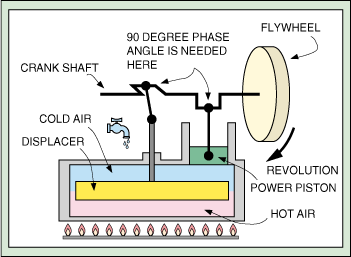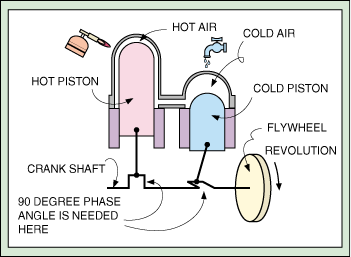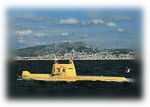Frequently Asked Questions:
Polish translation
- How do Stirling Engines work?
- Are Stirling engines really the most efficient engines possible?
- If Stirling engines are so efficient, why don’t I have one in my car?
- Who was the Rev. Robert Stirling anyway?
- What are Stirling engines being used for today?
- Who invented this type of Stirling Engine?
- The world has thousands of low temperature difference heat sources why don’t you build a full power engine that uses them?
- Does American Stirling Company build any full power Stirling engines? If not, do you plan to build any?
- Where can I get a 5 to 25 kW Stirling engine for my house, car, boat, etc. that will run on any fuel from cow chips to sunshine and be price competitive with a Honda generator of the same capacity?
- Could a good Stirling engine be built by starting with a small-block Chevy V8, or perhaps an air compressor, and converting it to a Stirling?
- May I use some of your photographs or drawings on my web-site or in print?
- I’d like to learn more about Stirling Engines, what should I do?
Questions and Answers:
- Q: How do Stirling Engines work?A: Stirling engines can be hard to understand. Here are the key points. Every Stirling engine has a sealed cylinder with one part hot and the other cold. The working gas inside the engine (which is often air, helium, or hydrogen) is moved by a mechanism from the hot side to the cold side. When the gas is on the hot side it expands and pushes up on a piston. When it moves back to the cold side it contracts. Properly designed Stirling engines have two power pulses per revolution, which can make them very smooth running. Two of the more common types are two piston Stirling engines and displacer-type Stirling engines. The two piston type Stirling engine has two power pistons. The displacer type Stirling engine has one power piston and a displacer piston.
Displacer Type:
The displacer type Stirling engine is shown here. The space below the displacer piston is continuously heated by a heat source. The space above the displacer piston is continuously cooled. The displacer piston moves the air (displaces the air) from the hot side to the cold side. The MM-1 Coffee Cup Stirling engine is this type of engine. However, the MM-1 should never be heated with any heat source hotter than boiling water.
Additional Detail:
Still Illustrations
Animated IllustrationsTwo Piston Type:
The two piston type Stirling engine is shown here. The space above the hot piston is continuously heated by a heat source. The space above the cold piston is continuously cooled.
Additional Detail:
Still Illustrations
Animated Illustrations
Flash Animation - Q: Are Stirling engines really the most efficient engines possible?A: In the mid 1800’s a very bright Frenchman named Sadi Carnot figured out the maximum efficiency possible with any heat engine. It is a formula like this (Temperature of the hot side – Temperature of the cold side)/Temp of hot side x 100 equals the max theoretical efficiency. Of course the temperatures must be measured in degrees Kelvin or Rankine. Stirling engines (with perfect regeneration) match this cycle. Real Stirling engines can reach 50 percent of the maximum theoretical value. That is an incredibly high percentage!
- Q: If Stirling engines are so efficient, why don’t I have one in my car?A: The best answer for that is to pick the MM-1 engine up after it gets up to speed. Notice that it keeps running for a minute or so. While it’s very easy to build a Stirling engine that will stop instantly, there is not one thing in the world anyone can do to make one start instantly. When I get in my car I want it to start immediately (if not sooner) and be able to burn rubber off the tires as I leave the parking lot! Stirling engines can’t do that. In spite of these limitations, Ford, GM, and American Motors Corp. spent millions of dollars developing Stirling engines for cars, back in the 1970’s. Ford even built a Stirling that could drive away from the curb (with relatively low power) twenty seconds after you turned the start key! Many prototypes were built and tested. Then oil prices came down in the 1980’s, and people started to buy bigger cars. Suddenly there was no compelling reason to build an engine that was substantially more efficient than internal combustion engines, but wouldn’t start instantly.
 Here is a picture of a 1979 AMC Spirit. It was equipped with an experimental Stirling engine powerplant called the “P-40”. The Spirit was capable of burning gasoline, diesel, or gasohol. The P-40 Stirling engine promised less pollution, 30% better mileage, and the same level of performance as the car’s standard internal combustion engine. [From “An Introduction to Stirling Engines”] The French Research Sub Saga is Stirling engine powered. Stirling engines also work exceptionally well as auxiliary power generators/heaters on yachts, where their silence is valued and good cooling water is available. They would also work very well in airplanes where the air gets colder as the plane climbs to altitude. There is no aircraft power plant (jets included) that gets any improvement in any operating conditions from climbing. Stirling engines won’t lose as much power as they climb as do either piston engines or jets. Also wouldn’t you like to have silent airplanes with very efficient engines that also have exceedingly low vibration levels?
Here is a picture of a 1979 AMC Spirit. It was equipped with an experimental Stirling engine powerplant called the “P-40”. The Spirit was capable of burning gasoline, diesel, or gasohol. The P-40 Stirling engine promised less pollution, 30% better mileage, and the same level of performance as the car’s standard internal combustion engine. [From “An Introduction to Stirling Engines”] The French Research Sub Saga is Stirling engine powered. Stirling engines also work exceptionally well as auxiliary power generators/heaters on yachts, where their silence is valued and good cooling water is available. They would also work very well in airplanes where the air gets colder as the plane climbs to altitude. There is no aircraft power plant (jets included) that gets any improvement in any operating conditions from climbing. Stirling engines won’t lose as much power as they climb as do either piston engines or jets. Also wouldn’t you like to have silent airplanes with very efficient engines that also have exceedingly low vibration levels? - Q: Who was the Rev. Robert Stirling anyway?A: Robert Stirling was a minister of the Church of Scotland who was interested in the health of his parishioners bodies in addition to the well being of their souls. He invented the Stirling engine (he called it an “air engine”) because steam engines of his day would often explode killing and maiming those who were unlucky enough to be standing close by. Robert Stirling’s engines couldn’t explode and produced more power than the steam engines then in use. In 1816 he received his first patent for a new type of “air engine”. The engines he built and those that followed eventually became known as “hot air engines” and continued to be known called hot air engines until the 1940’s when other gasses such as helium and hydrogen were used as the working fluid. Robert Stirling was an active minister and inventor all his life. Perhaps his most important invention was the “regenerator” or “economizer” as he called it. This is used today in Stirling engines and many other industrial processes to save heat and make industry more efficient.
- Q: What are Stirling engines being used for today?A: The modern uses of Stirling engines are invisible to almost everyone. There have been many research engines built in recent years but there are only three areas where Stirling engines have made a dramatic impact.
 There are Stirling engines in Submarines, stirling machines used as cryocoolers, and Stirling engines in classrooms. Cryogenics is the science of things that are exceedingly cold and Stirling engines are one tool that can be used to make things exceedingly cold. It’s not obvious but a Stirling engine is a reversible device. If you heat one end and cool the other, you get mechanical work out, but if you put mechanical work in, by connecting an electric motor, one end will get hot and the other end will get cold. If you design the machine correctly, the cold end will get extremely cold. In fact, Stirling coolers have been made that will cool below 10 degrees Kelvin. Micro Stirling coolers have been produced in large numbers for cooling infrared chips down to 80 degrees Kelvin for use in night vision devices.
There are Stirling engines in Submarines, stirling machines used as cryocoolers, and Stirling engines in classrooms. Cryogenics is the science of things that are exceedingly cold and Stirling engines are one tool that can be used to make things exceedingly cold. It’s not obvious but a Stirling engine is a reversible device. If you heat one end and cool the other, you get mechanical work out, but if you put mechanical work in, by connecting an electric motor, one end will get hot and the other end will get cold. If you design the machine correctly, the cold end will get extremely cold. In fact, Stirling coolers have been made that will cool below 10 degrees Kelvin. Micro Stirling coolers have been produced in large numbers for cooling infrared chips down to 80 degrees Kelvin for use in night vision devices. - Q: Who invented this type of Stirling Engine?A: Some history: In 1983 Ivo Kolin, a professor at the University of Zagreb in what was then Yugoslavia, demonstrated the first Stirling engine that would run on small temperature differences. After he published what he had done, Dr. James Senft, a Mathematics professor at the University of Wisconsin River Falls built the first engines similar to the MM-1. The model MM-1 would not have been possible without the work of these two people. The concept for the MM-1 came from the innovative mind of Darryl Phillips. All the detail design and engineering work for the MM-1 was done by Brent H.Van Arsdell president of American Stirling Company.
- Q: The world has thousands of low temperature difference heat sources why don’t you build a full power engine that uses them?A: Stirling engines that run on small temperature differences tend to be very large for the amount of power they put out. While we clearly could build engines that produce power and ran on small temperature differences, here’s why we have not chosen to do that. As the temperature difference available to run a Stirling engine decreases, the size of the engine required for a given amount of power increases. For example check out our beautiful model MM-6. This engine runs on the heat of your warm hand and puts out an immeasurably small amount of power. Engines that produce power and run on small temperature differences can be built, but they will be large (usually impractically large) for the amount of power they put out.A good general guideline is that if the hot side of the engine is not at least 500 deg. F. (260 deg. C) the engine will be too bulky for the amount of power it puts out.
- Q: Does American Stirling Company build any full power Stirling engines? If not, do you plan to build any?A: We currently build only educational and demonstration Stirling engines.We would love to build power producing Stirling engines, but we currently do not have the resources to finance such a project.
- Q: Where can I get a 5 to 25 kW Stirling engine for my house, car, boat, etc. that will run on any fuel from cow chips to sunshine and be price competitive with a Honda generator of the same capacity?A: As I write this in March of 2002 you can’t get such an engine. There are some Stirling engines available for those who have a military or hefty commercial budget. There is also one engine that puts out 750 watts and is designed to heat and power yachts and remote residences. See our links page for details.While it would be very nice if such an engine existed at a price per kW that is competitive with gasoline or diesel engines, that probably isn’t realistic at first. Gasoline and diesel generators are manufactured by the millions. When a 5 to 25 kW Stirling engine design first reaches the market it will initially be manufactured in much lower quantities and so undoubtedly will cost more per kW than competitive gasoline and diesel engines.
- Q: Could a good Stirling engine be built by starting with a small-block Chevy V8, or perhaps an air compressor, and converting it to a Stirling?A: This has been tried many times by many different people and the conclusion is that it really doesn’t help all that much. In his book Making Stirling Engines, Andy Ross describes converting an automobile freon compressor to a Stirling engine. The conclusion of Andy and others is that while this approach can be made to work, there are too many compromises when you start with some parts that were made for some other use. You might as well build the entire machine as a purpose built Stirling engine.
- Q: May I use some of your photographs or drawings on my web-site or in print?A: Yes most of the time. You may always use the pictures of our engines on the web if you include a link to our home page https://www.stirlingengine.com . In print you may use our pictures if you print a photo credit which says, “Used by permission of www.stirlingengine.com” If you would like to re-publish our content in other ways, please call us or e-mail us.
- Q: I’d like to learn more about Stirling Engines, what should I do?A: We suggest purchasing a copy of “Around the World by Stirling Engine” as a very good overview of Stirling Engines. But the best way to really understand Stirling engines is to hold one of our transparent engines in your hands and carefully watch it run. So enjoy our web site, but make sure to come back and browse our Stirling engine store.
